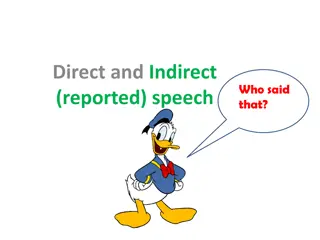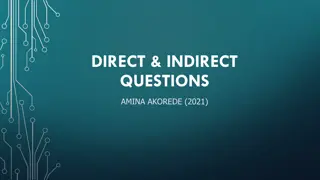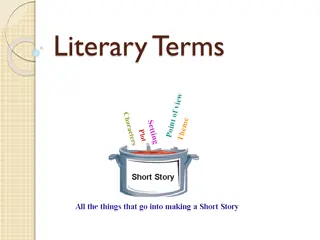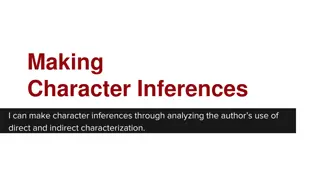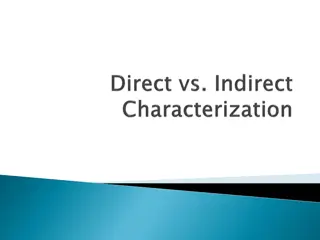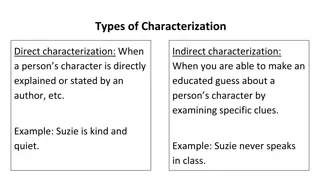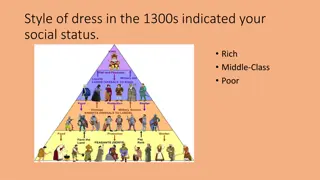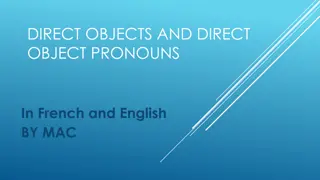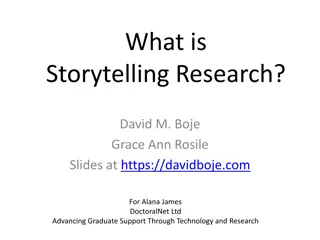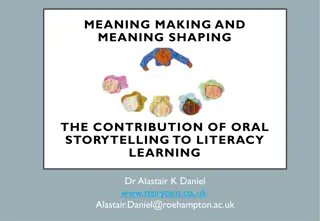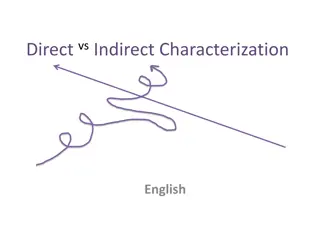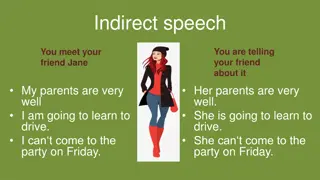Understanding Direct vs. Indirect Characterization in Storytelling
Characterization is key in storytelling to develop characters effectively. Direct characterization involves explicitly stating a character's traits, while indirect characterization reveals traits through actions, thoughts, and interactions. Examples illustrate the difference between the two methods, highlighting how they shape a character's portrayal in a narrative.
Download Presentation

Please find below an Image/Link to download the presentation.
The content on the website is provided AS IS for your information and personal use only. It may not be sold, licensed, or shared on other websites without obtaining consent from the author. Download presentation by click this link. If you encounter any issues during the download, it is possible that the publisher has removed the file from their server.
E N D
Presentation Transcript
Direct vsIndirect Characterization Mrs. King
What a story needs The development of the characters, which is known as characterization, is extremely important to bring out the essence of the story. Characterization is the process through which the writer brings forth the nature, personality, and physical appearance of the characters for the reader's better understanding of them. There are TWO ways to characterize: 1. Direct Characterization 2. Indirect Characterization
Ta-Ta-Ta-Tell me the difference! Direct Characterization directly & straight up telling the reader the character s actual physical and mental traits. Think telling. Indirect Characterization indirectly & not outright providing the reader with information but forcing the reader to use their imagination; author will only show how the character speaks, thinks, acts, or how other characters react to him. Think showing.
The Difference: In Visual Form. Direct Characterization author tells the character s actual physical and mental traits, characteristics, abilities. Think telling. Indirect Characterization author shows how character speaks, thinks, acts, or how other characters react to him. Think showing.
S.T.E.A.L. Method S what character says T what character thinks E what effect character has on others A how the character acts L what character looks like
Stop, Read, Understand the Examples: Example # 1 Direct - Jane was a beautiful young girl. She had golden hair and blue eyes, which made her stand out from the rest. Indirect - When Jane walked in the room, nobody could help but look at her stunning, gorgeous face. She commanded attention wherever she went due to her good looks.
Stop, Read, Understand the Examples: Example # 2 Direct - Jim was an honest, truthful man. He never cheated anybody in his entire life. Indirect - Jim was very unlike any other businessman. He made sure that all his clients got what they had paid for.
Stop, Read, Understand the Examples: Example # 3 Direct - John cared a lot for the well-being of others. There was an old couple living alone near his house. John used to buy weekly groceries for them and even check on them everyday, just to see how they are doing. Indirect - An old couple living near John's house considered him just like their own son. John did all that for them what even a son these days won't do. He would shop for them, get them things and say hello everyday.
Turn these INDIRECTS into DIRECT: 1. As Mr. Bird walked by, mothers pulled their children really close to them. 2. Kylie's name was called, and she slowly walked toward the stage while staring at the ground. 3. Tom cried and cried when my goldfish died. 4. Ali s ability to notice the smallest or most incorrect of details in the movie stunned me.
INDIRECTS into DIRECT: 1. As Mr. Bird walked by, mothers pulled their children really close to them. Mr. Bird smelled of sweat, wore tattered clothes, and had scruff across his face. 2. Kylie's name was called, and she slowly walked toward the stage while staring at the ground. Indeed, Kylie was afraid of crowds as she had complete stage fright. 3. Tom cried and cried when my goldfish died. Tom was an extremely sensitive, emotional guy who loved animals, especially fish. 4. Ali s ability to notice the smallest or most incorrect of details in the movie stunned me. Ali was the most observant and perceptive movie-goer I knew.
Turn these INDIRECTS into DIRECTS: 1. Seriously, Lou is an amazing musician. 2. Judy really is such a wonderful friend. 3. Arnold, my neighbor, is a total klutz. 4. Mrs. Monte is the most unorganized lady!
Turn these INDIRECTS into DIRECTS: 1. Seriously, Lou is an amazing musician. Lou has an aptitude for music; he effortlessly plays any instrument, causing crowds to immediately stop to listen to him. 2. Judy really is a such wonderful friend. Judy treats each of her friends with respect and sympathy, treating their every need before her own. 3. Arnold, my neighbor, is a total klutz. Not a soul can trust Arnold with their fragile items; he has countless times been caught tripping up the stairs. He is why we can t have nice things! 4. Mrs. Monte is the most unorganized lady! Atop Mrs. Monte s desk sit mounds and mounds of scattered paper. Finding any material she needs is a rough task who knows where it is!?
a VISUAL refresher refresher! Watch this quick, cute clip on the STEALMethod of understanding indirect characterization: https://www.youtube.com/watch?v=kHt8RjkFs98
Now, remind ME. FIRST: Define, in a complete sentence, Direct Characterization. Direct characterization outright tells the actual traits, attributes, or mental traits of a character. SECOND: Define, in a complete sentence, Indirect Characterization. Indirect characterization only shows the traits, attributes, or mental traits of a character through actions or thoughts of theirs, reactions of others, behaviors. What is a way to remember the difference between the two? This remembrance is up to YOU!
Is all of that clear as a bell? If your ears are ringing, then you ve got it! So, let s test your knowledge: in your notes, jot down a classmate. After that, characterize them directly. Then, characterize them indirectly. Generate this like the examples on the previous slides. We will Pair N Share once done! BUZZZZZ TO IT!



